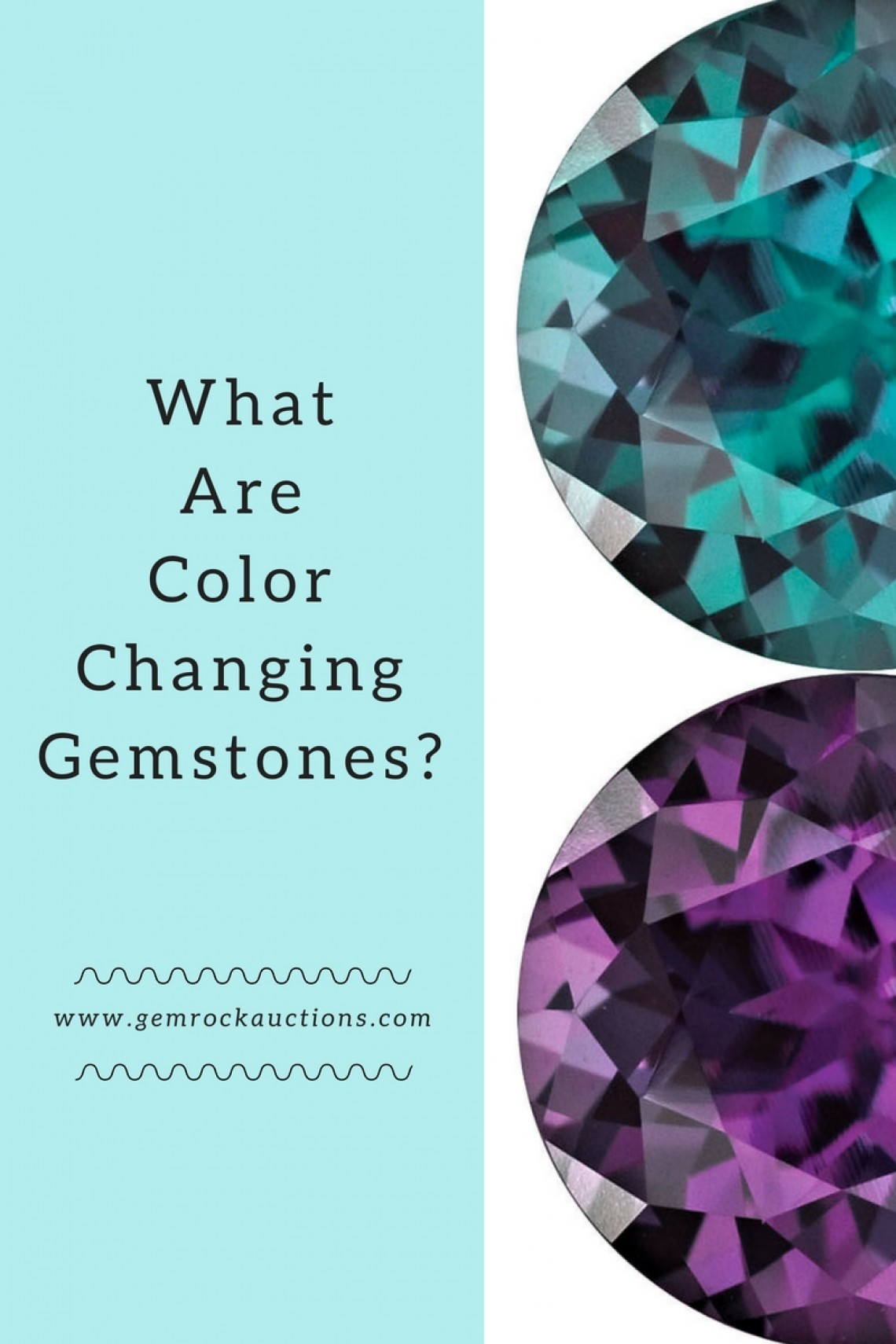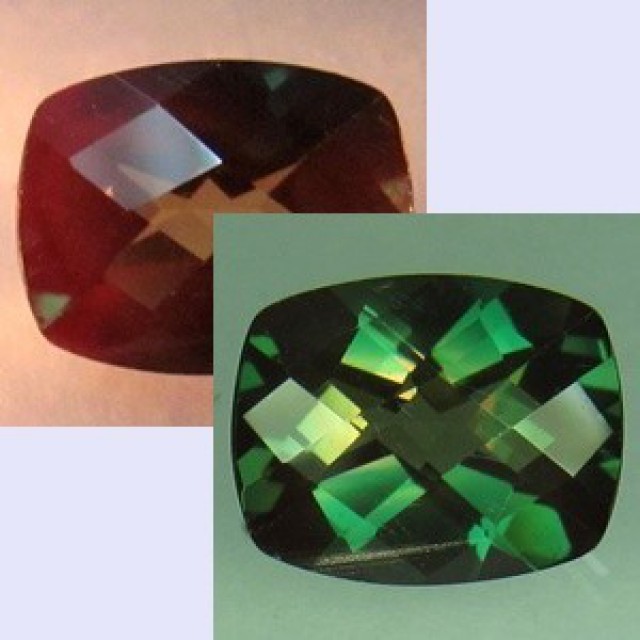
公開日9th May 2018
変更日時11th Aug 2025
色が変わる宝石
 色が変わる宝石があることをご存知ですか?美しい宝石の中には、自然光、蛍光灯、室内照明など、様々な光源の下で色が変わるものがあります。これらの色が変わる宝石は、アレキサンドライト、ガーネット、一部のサファイアなど、様々な鉱物のグループから生まれています。
色が変わる宝石があることをご存知ですか?美しい宝石の中には、自然光、蛍光灯、室内照明など、様々な光源の下で色が変わるものがあります。これらの色が変わる宝石は、アレキサンドライト、ガーネット、一部のサファイアなど、様々な鉱物のグループから生まれています。
色が変化する宝石については、依然として多くの混乱が見られます。白熱灯と蛍光灯の違いを確認するという古い手法を依然として使っている人もいますが、これは不十分です。さらに悪いことに、色の変化を全く確認しない人もいます。これは現代宝石学の最も重大な弱点の一つであり、定期的に対処する必要があります。
どの宝石が色が変わるのでしょうか?
アンデシンの色の変化
この美しい宝石は長石の一種で、自然界では黄色、赤、緑、あるいは色を変える宝石として産出されます。アンデシンの大部分は加熱処理によって赤色に変化しますが、天然の赤色のものはごくわずかです。アンデシンはチベットとモンゴルで採掘されていますが、色を変える性質を持つものはごくわずかです。色を変える性質を持つ石は、光の当たり方によって深緑から鮮やかな紫まで、驚くほど多様な色彩を呈します。
ダイアスポアの色の変化
色が変わるダイアスポアが初めて宝石市場に登場した際、商標名はズルタナイトでした。色が変わる標本を採掘した会社にちなんで名付けられましたが、商標名は定着せず、現在でも鉱物学上の名称で呼ばれることが多いです。この非常に希少な石は世界中で見つかりますが、採掘されるのはトルコのアナトリア山脈のみです。色が変わる特性に加え、ダイアスポアは多色性も示します。つまり、異なる角度から見ると色の帯が見えるということです。色が変わるダイアスポアはマンガンから発色し、光源によって鮮やかな緑、ピンク、シャンパングリーンへと変化します。
フローライトの色の変化
フローライトの標本は、鮮やかな赤、青、紫、緑、黄色から、より濃い茶色や赤まで、驚くほど多様な色彩を呈します。中には様々な色彩を持つ標本もありますが、一般的には単色の宝石として発見されています。色が変化するフローライトは、自然光の下では青色、白熱灯の下では紫色に変化するものがほとんどです。この手頃な価格で魅力的な石は、比較的柔らかいため、ペンダント、イヤリング、ブレスレットなど、摩耗の少ない用途に最適です。
アレキサンドライトの色の変化
クリソベリルの一種であるアレキサンドライトは、最も高価な変色宝石の称号を誇ります。アレキサンドライトは、ロシア皇帝アレクサンドル2世にちなんで名付けられたと考えられています。エメラルド鉱山で初めて発見された際、その緑色からエメラルドと誤認されました。この変色宝石は、日中はエメラルドグリーン、夜間は赤へと変化するという驚くべき特性を持っています。また、自然光の下では青みがかった色合いを、人工光の下では紫色に変化する様子も観察されています。アレキサンドライトは、どんなジュエリーでも話題になる、ユニークで美しい石です。
ガーネットの色の変化
カラーチェンジガーネットは、アレキサンドライトと間違われることが多いですが、ガーネットの中でも美しく希少な鉱物です。他の多くの変色鉱物と同様に、カラーチェンジガーネットは見る光の種類によって色が変化します。自然光の下では、これらのガーネットは一般的に茶色がかった緑色を呈しますが、人工光の下ではピンク色に変化します。しかし、ガーネットはそれぞれ独自の色の組み合わせを持つこともあり、青、黄、オレンジ、紫など、様々な色合いが考えられます。カラーチェンジガーネットは、マダガスカル、ノルウェー、スリランカ、タンザニア、アメリカ合衆国など、世界各地で産出されます。
サファイアの色の変化
希少なサファイアの中には、異なる照明条件下で見ると色が変化するものがあります。色の変化の強さは石によって異なり、大きく変化するものもあれば、わずかな変化しか見られないものもあります。最も一般的なサファイアは、自然光では青く見え、人工照明下では紫色に変化します。カラーチェンジサファイアは、あらゆる照明条件下で2つの異なる色の帯を持つバイカラーサファイアと混同しないようご注意ください。
色が変わる宝石の色の変化の定義
まず、色の変化は自然光と人工光の違いによって定義されるということを指摘しておきます。少し考えてみれば、その理由は明らかです。電灯が登場したのはほんの1世紀ちょっと前ですが、変色宝石の色の変化現象はそれよりずっと以前から知られていました。もともとは、太陽光とろうそく、石油ランプなど、火の光の違いとして定義されていました。白熱灯が普及するにつれて、太陽光と火の光を比較するのと同じ効果が得られるようになったため、定義は自然光と電灯の光の違いへと変更されました。
以下はガーネットの写真です。ガーネットは現在市場で最も広く流通している変色宝石の一つです。


これは、色が変わる宝石の色の変化を定義する標準です。これは、自然光(つまり、太陽光)とその他の光源で見える色の違いです。
蛍光灯が加わったことで、色が変わる宝石の定義は再び修正される必要がありました。蛍光灯は自然光と同じ色合いを示すことが多いため、人々は2種類の電灯を使って色の変化を確認するようになりました。しかし、現在では、蛍光灯に自然光と同じように反応しない色が変わる宝石があることが分かっています。そのため、色の変化を確認する際に2種類の電灯を使用するのはもはや適切ではありません。
色が変わる宝石の色の変化を確認する
多くの人は、宝石の色の変化をほんの少ししかチェックしません。この残念な事実は、一つの明白な例で明らかです。数年前、ハリウッドの著名な一族がGIAにダイヤモンドの鑑定を依頼しました。しかし、鑑定書には、ダイヤモンドの価値に大きく影響する色が変わる宝石であることは一切記載されていませんでした。セキュリティ上の理由から、鑑定エリアには窓がありませんでした。また、それまで色の変化ダイヤモンドについて誰も聞いたことがなかったため、検査は不要と判断されました。現在では、色の変化ダイヤモンドは非常に希少で価値が高いことが分かっています。これらは一般にカメレオンダイヤモンドと呼ばれています。
以下は、色の変化があまり考慮されていない鉱物の一つ、アンデシンの写真です。すべての宝石において、この特性を確認することをお勧めします。

ここ数十年で、多くの新しいカラーチェンジ宝石が誕生し、次々と発見されています。Gem Rock Auctionsでは、カラーチェンジスフェーンが販売されています。カラーチェンジスフェーンという言葉は初めて聞きましたが、確かに存在するようです。もし誰かがこれらの宝石をわざわざ確認していなかったら、見落とされていたでしょう。
教訓はシンプルです。すべての宝石の色の変化をチェックする必要があるということです。私たちは自然が私たちに与えてくれるものをすべて知っているわけではありません。そして、このような重要な情報を見逃す言い訳はありません。
色が変わる宝石の物理学
宝石の色が変化するメカニズムは実にシンプルです。光源ごとに異なる指紋があります。つまり、可視光は様々な波長で構成され、それぞれ異なる色を呈するのです。

上の画像では、正午の太陽光(黄色の線)がほぼすべての色を含む比較的平坦な線になっていることが簡単にわかります。蛍光灯を見ると、青はあまりなく、黄色と赤が多いことに気づくでしょう。
さて、アレキサンドライトを見てみましょう。日光の下では緑色、白熱灯の下では赤色に見えます。上の黄色と青の線を見ると、日光は赤色よりも緑色が多いことが容易にわかります。つまり、人間の目にはアレキサンドライトは緑色に見えます。青の線を見ると、赤色に比べて緑色が比較的少ないことがわかります。つまり、人間の目にはアレキサンドライトは赤色に見えます。
これは実際に起こっていることを非常に簡略化した説明です。より複雑な説明には、波長の選択吸収についての話が必要になりますが、それはまた別の機会にお話ししましょう。
色が変わる宝石のさらなるテスト
このプロセスはますます複雑になっています。最近、3通りの色の変化を示す宝石が2つ発見されました。自然光の下では1つの色が現れ、白熱灯の下では別の色が現れ、蛍光灯の下ではさらに別の色が現れます。
今では非常に多くのバリエーションが登場しているので、自然光と蛍光灯の間でのみ色の変化が見られ、自然光と白熱灯の間では全く色の変化が見られない宝石が存在する可能性もあります。そのような石については聞いたことがありませんが、可能性はあります。
ウサンバラ効果
ウサンバラ効果と呼ばれる新しい現象も、同様に色の変化を引き起こします。しかし、これはこれまで知られていたものとは全く異なる原理に基づいています。この効果は宝石以外にも現れます。パンプキンシードオイルはこの効果の素晴らしい例です。ボトルの中では赤く見えますが、スプーンに注ぐと次のような変化が起こります。

液体の縁の周りが緑色に変わります。なぜそうなるのでしょうか?簡単に言うと、これは光吸収によるもので、光の透過経路に直接関係しています。つまり、光が液体中を長く進むほど、特定の波長の吸収が大きくなります。つまり、上のスプーンでは、光は液体中をそれほど長く進む必要がないため、緑色の波長は液体中を透過できるのです。
液体が一定の厚みに達すると、緑色の波長の光は吸収されすぎて透過しなくなり、残るのは赤色の波長のみになります。
この効果はトルマリンにも見られます。下の写真は、外側の縁が緑色、内側の縁が赤色のトルマリンです。

色が変わる宝石を買う
Gemstone Encyclopedia検索
最新記事
レインボーラティスサンストーンは、様々な内包物によって3つのゴージャスな光学的効果を持つ長石の一種です。燃えるように鮮やかな色合いと格子模様が、コレクターにとって希少な宝石となっています。
12th Jan 2026
チューライトは、ゾイサイト鉱物ファミリーに属する、鮮やかなバラ色の色合いを示す希少なノルウェー産の宝石で、ジュエリーのセッティングやペンダントによく使用されます。
6th Jan 2026
ビスムトタンタライトは、タンタライト鉱物群に属する希少な鉱物宝石です。比較的柔らかいため、ジュエリーセッティングには適していません。しかし、コレクターにとっては貴重なアイテムです。
5th Jan 2026
記事のカテゴリ
How To's is where you will find helpful articles from gem Rock Auctions on how to cut gemstones, select gemstones and buy gemstones.
9記事数



